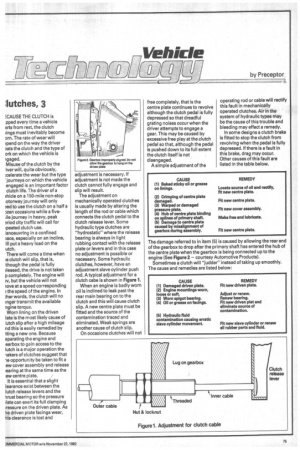lutches, 3
Page 49

If you've noticed an error in this article please click here to report it so we can fix it.
ECAUSE THE CLUTCH is pped every time a vehicle arts from rest, the clutch lings must inevitably become orn. The rate of wear will mend on the way the driver 3ats the clutch and the type of ork on which the vehicle is 'gaged.
Misuse of the clutch by the iver will, quite obviously, :celerate the wear but the type ' journeys on which the vehicle engaged is an important factor clutch life. The driver of a shicle on a 150-mile non-stop otorway journey will only 3ed to use the clutch on a half a ozen occasions while a fiveile journey in heavy, peak 3riod city traffic will call for peated clutch use.
lanoeuvring in a confined )ace, especially on an incline, ill put a heavy load on the utch.
There will come a time when clutch will slip, that is, though the pedal is fully )leased, the drive is not taken p completely. The engine will At, but the vehicle will not vove at a speed corresponding ) the speed of the engine. In ther words, the clutch will no inger transmit the available ngine torque.
Worn lining on the driven late is the most likely cause of lutch slip after a high mileage nd this is easily remedied by fling a new one. Because operating the engine and earbox to gain access to the lutch is a major operation the lakers of clutches suggest that le opportunity be taken to fit a ow cover assembly and release earing at the same time as the ew centre plate.
It is essential that a slight learance exist between the lutch release levers and the nrust bearing so the pressure ■ late can exert its full clamping )ressure on the driven plate. As he driven plate facings wear, his clearance is lost and adjustment is necessary. If adjustment is not made the clutch cannot fully engage and slip will result, The adjustment on mechanically operated clutches is usually made by altering the length of the rod or cable which connects the clutch pedal to the clutch release lever. Some hydraulic type clutches are "hydrostatic" where the release bearing is always in light rubbing contact with the release plate or levers and in this case no adjustment is possible or necessary. Some hydraulic clutches, however, have an adjustment slave cylinder push rod. A typical adjustment for a clutch cabe is shown in Figure 1. When an engine is badly worn oil is inclined to leak past the rear main bearing on to the clutch and this will cause clutch slip. A new centre plate must be fitted and the source of the contamination traced and eliminated. Weak springs are another cause of clutch slip. On occasions clutches will not free completely, that is the centre plate continues to revolve although the clutch pedal is fully depressed so that dreadful grating noises occur when the driver attempts to engage a gear. This may be caused by excessive free play at the clutch pedal so that, although the pedal is pushed down to its full extent the clutch itself is not disengaged.
A simple adjustment of the operating rod or cable will rectify this fault in mechanically operated clutches. Air in the system of hydraulic types may be the cause of this trouble and bleeding may effect a remedy.
In some designs a clutch brake is fitted to stop the clutch from revolving when the pedal is fully depressed. If there is a fault in this brake, drag may occur. Other causes of this fault are listed in the table below.


















































